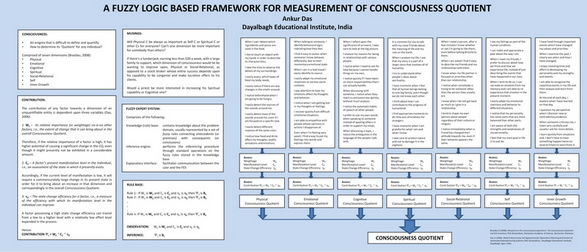by Ankur Das (Dayalbagh Educational Institute, Agra, India)
Poster paper presented at The Science of Consciousness Conference, Tucson, 2016
Consciousness is an enigma that is as difficult to define as it is to quantify. In the recent past, it has been considered to be comprised of the following seven dimensions for determining the value of overall Consciousness Quotient – Physical, Emotional, Cognitive, Spiritual, Social-Relational, Self and Inner Growth. In this paper, factors that contribute to the variation of each of these dimensions are defined.
The contribution of any factor towards a dimension of an unquantifiable entity such as consciousness in this case, can be viewed to be dependent upon the following three variables:
First, its relative importance (or weightage) vis-a-vis other factors, i.e., the extent of change that it can bring about in that dimension of consciousness and eventually in the overall Consciousness Quotient. Therefore, if the relative importance of a factor is high, it has a higher potential of causing a significant change in the CQ, even though it might presently not be exhibited in a considerable amount.
Second, a factor’s present manifestation level in the individual, i.e., an assessment of the state in which it presently exists. Accordingly, if the current level of manifestation is low, it will require a commensurately large change in its present state in order for it to bring about an increase in that dimension and correspondingly in the overall Consciousness Quotient.
Third, the state change efficiency for a factor, i.e., a measure of the efficiency with which its manifestation level in the individual can improve. A factor possessing a high state change efficiency can transit from a low to a higher level with a relatively low effort level expended in the process.
This paper presents a novel fuzzy logic-based approach for measuring consciousness that exploits linguistic variables for quantifying the contribution of factors affecting dimensions of consciousness. Towards this end, such factors are identified and a framework, for measuring their contribution for their respective dimensions in order to compute the Consciousness Quotient, is given.

